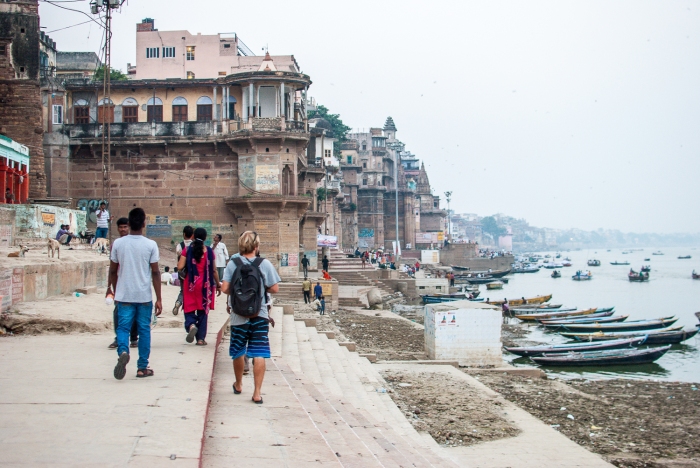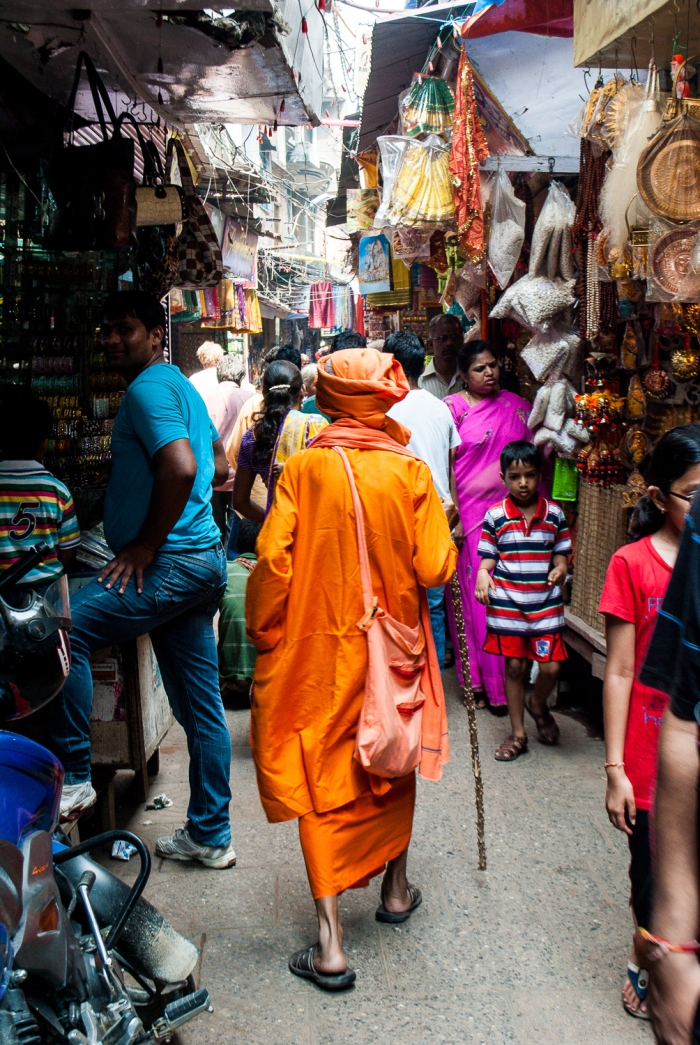It’s hard to find the words to accurately paint a picture of just how intense Varanasi really is. As the country’s holiest city, Varanasi is definitely India at it’s most unashamedly Indian and highlights just how much you can love and hate this country at the same time. In any case, it was certainly a fitting city to spend our last few days in India.
We arrived in Varanasi after a very delayed, very long train trip from Rishikesh and found ourselves in a tuk tuk battling the crowds who were out in force to celebrate the a festival called Dashain. Apparently 20 million people came to Varanasi to celebrate the festival, which obviously added to the intensity of this already overcrowded city.
We found a hotel and then moved again the next morning as the bed was the worst on our travels yet- we put down all of our blankets and some yoga mats and it was still as though we were lying on concrete slabs. That day we took a short walking tour with Gopal, one of the workers at our new hotel who looked constantly stoned and has red teeth from all the paan (tobacco) that most Indian men are constantly sucking.
Gopal took us down to the Ganga (River Ganges), India’s most beloved, holiest river that is the source of life for all Indians that draws hundreds of millions of people to it every year. Many people live their lives to die in Varanasi and be cremated next to the Ganga and many people come to this city to await their deaths, only to wait another few decades. Gopal knew one lady who came to Varanasi to die and is still waiting 35 years later.
The scenes that we saw down at the Ganga are some of the most intense I have seen in all my years traveling. People come to bathe daily, washing themselves, dunking themselves in the river, gargling and drinking the water while someone else goes to the bathroom 2 meters away and herds of buffalo sit calmly next to them, almost fully submerged in the water to escape the intense heat. Not 50 meters away, you can see bodies of faithful Indians being cremated 24 hours a day at the burning Ghat. Wood is piled up by the Untouchables, India’s lowest ranks of a still very prevalent caste system, while the body of the dead wrapped in white cloth and bright metallic material, is carried down to the river by male family members chanting prayers. After being washed in the Ganga one last time, the body is placed on the wood and sprinkled with sandalwood to mask the smell, then being set alight after the family says their prayers and watches, along with any other spectator, as the body burns. The Untouchables make sure the body is burning properly, poking it back into the fire with a long stick and keeping the fire burning while opportunistic dogs scavenge around in search of a bone.
Once the fire is out after a few hours, the Untouchables gather the ashes to find the chest bone (male) and pelvis (female) that they then throw into the river. The ashes pile up on the shore of the river, and are sifted through in search of silver and gold teeth fillings, as well as womens’ jewellery that the Untouchables are then allowed to sell. In the mean time, the male family members of the dead shave their heads and bathe in the river next to the cremation point.
Not all bodies are burned – Sadhus, pregnant women, children under 12, lepers, people who have been bitten by a cobra and cows are already considered pure. Instead, these bodies are tide to a large rock and simply dumped in the middle of the river, about 30 meters from the shore. Though we thankfully didn’t see any, apparently these bodies often float to the top and then to the east side of the river where they are feed for many birds and dogs. Circle of life, I guess. You would imagine that there are some extreme health issues raised from all of this activity going on in the one river at the same time, but the locals will swear that it’s mind over matter and the Ganga is the source of life, not sickness.
We took a boat ride for sunset and saw a ceremony that happens everyday by the river – it seems everyone had the same idea as us as we were surrounded by boats filled with Indian families and tourists. We also took a stroll through the tiny little streets that lead down to the river which, like many indian cities, were packed full of people, touts, motobikes, goats, cows, shops, chaiwallas – absolute chaos. We saw our first fight between two bulls that ended up knocking over and trampling about 6 motorbikes while terrified Indians jumped out of the way of where we were standing not 30 seconds before.
One of the days of Dashain, animals are slaughtered for the purpose of both sacrifices and feasts which, in a city as big as Varanasi, is a LOT of animals. Unbeknown to us, this happens on one of the main streets where we decided to walk one day and I almost slipped over from the layer of blood and innards that lay on the ground. The next day was cleanup day and, once again with impeccable timing, we got caught in a traffic jam caused by the tractor scooping up all of the remains to be taken and burned somewhere. Not the most pleasant experience.
The owner of the hotel we were staying in was very correct in saying that “India is like LSD – you can have a bad trip and you can have a good trip, but at least you’re having a trip”. Too true – we had great times in India and we had some times where I just wanted jump on a plane and get out as fast as possible, but it was certainly an experience we’ll never forget. Just over two months to the day since we arrived, we were happy to cross the border to Nepal to start a new chapter of the adventure.












Really love this blog…one of our favourites. Such a wonderful story teller Shailei and great photography Liam…if you took them. Can’t wait to hear about Nepal!